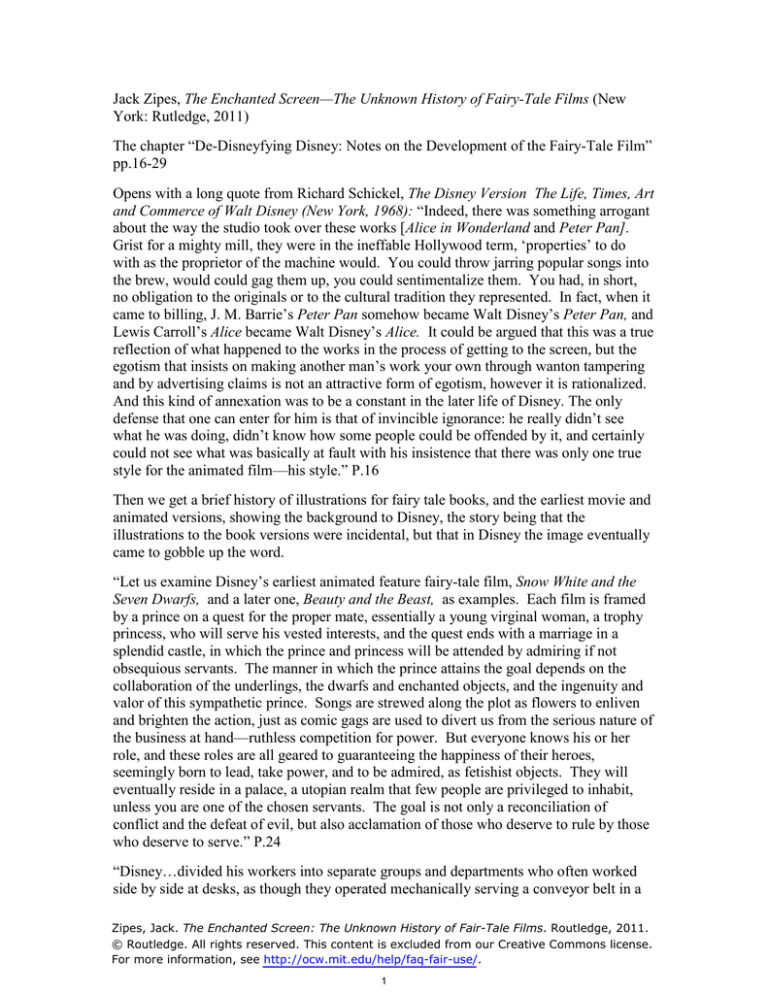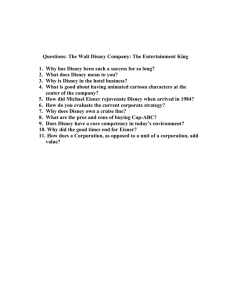
Jack Zipes, The Enchanted Screen—The Unknown History of Fairy-Tale Films (New
York: Rutledge, 2011)
The chapter “De-Disneyfying Disney: Notes on the Development of the Fairy-Tale Film”
pp.16-29
Opens with a long quote from Richard Schickel, The Disney Version The Life, Times, Art
and Commerce of Walt Disney (New York, 1968): “Indeed, there was something arrogant
about the way the studio took over these works [Alice in Wonderland and Peter Pan].
Grist for a mighty mill, they were in the ineffable Hollywood term, ‘properties’ to do
with as the proprietor of the machine would. You could throw jarring popular songs into
the brew, would could gag them up, you could sentimentalize them. You had, in short,
no obligation to the originals or to the cultural tradition they represented. In fact, when it
came to billing, J. M. Barrie’s Peter Pan somehow became Walt Disney’s Peter Pan, and
Lewis Carroll’s Alice became Walt Disney’s Alice. It could be argued that this was a true
reflection of what happened to the works in the process of getting to the screen, but the
egotism that insists on making another man’s work your own through wanton tampering
and by advertising claims is not an attractive form of egotism, however it is rationalized.
And this kind of annexation was to be a constant in the later life of Disney. The only
defense that one can enter for him is that of invincible ignorance: he really didn’t see
what he was doing, didn’t know how some people could be offended by it, and certainly
could not see what was basically at fault with his insistence that there was only one true
style for the animated film—his style.” P.16
Then we get a brief history of illustrations for fairy tale books, and the earliest movie and
animated versions, showing the background to Disney, the story being that the
illustrations to the book versions were incidental, but that in Disney the image eventually
came to gobble up the word.
“Let us examine Disney’s earliest animated feature fairy-tale film, Snow White and the
Seven Dwarfs, and a later one, Beauty and the Beast, as examples. Each film is framed
by a prince on a quest for the proper mate, essentially a young virginal woman, a trophy
princess, who will serve his vested interests, and the quest ends with a marriage in a
splendid castle, in which the prince and princess will be attended by admiring if not
obsequious servants. The manner in which the prince attains the goal depends on the
collaboration of the underlings, the dwarfs and enchanted objects, and the ingenuity and
valor of this sympathetic prince. Songs are strewed along the plot as flowers to enliven
and brighten the action, just as comic gags are used to divert us from the serious nature of
the business at hand—ruthless competition for power. But everyone knows his or her
role, and these roles are all geared to guaranteeing the happiness of their heroes,
seemingly born to lead, take power, and to be admired, as fetishist objects. They will
eventually reside in a palace, a utopian realm that few people are privileged to inhabit,
unless you are one of the chosen servants. The goal is not only a reconciliation of
conflict and the defeat of evil, but also acclamation of those who deserve to rule by those
who deserve to serve.” P.24
“Disney…divided his workers into separate groups and departments who often worked
side by side at desks, as though they operated mechanically serving a conveyor belt in a
Zipes, Jack. 7KH(QFKDQWHG6FUHHQ7KH8QNQRZQ+LVWRU\RI)DLU7DOH)LOPV. Routledge, 2011.
© Routledge. All rights reserved. This content is excluded from our Creative Commons license.
For more information, see http://ocw.mit.edu/help/faq-fair-use/.
1
factory. They were organized according to their functions: cell painters, animators,
musicians, gag men, storyboard producers, and directors. After 1935 Disney did not do
animating, composing, or screenplay writing and worked out of his own personal office.
However, he supervised almost every film, large and small, and his decision was the final
decision for almost all the early productions. To his credit, he sought out the very best
collaborators and rarely stinted when it came to improving the technical quality of his
productions…Most of all, he conceived many of the ideas behind the films and decided
what project would move forward and which collaborators would work on a particular
project…it was a shared spectacular vision of efficiency, exploitation, and expediency:
how best to use a story to promote one’s artistic talents, make money, market oneself, and
promote a vision of how social relations should be ordered. The contents and history of
the fairy tale were only a pre-text, that is, they provided the materials to be appropriated
and adapted for production purposes that served market ends. Behind such purposes, of
course, was an ideology commensurate with the capitalist mode of production and
commodity fetishism that was intended to shape the vision of audiences so that they
would want to see and consume more of the same.” P.24
The basis of the charge against Disney, although Zipes never articulates it clearly, is the
Marxist one frequently leveled against middleclass novelists, that in seeming to resolve
the conflicts in their works, they are complicit in papering over deep-lying inequalities
and divisions in capitalist society, a kind of trahison des clercs—or “betrayal of the
intellectuals”. [Echoes here of Dwight Macdonald’s Theory of Mass Culture, perhaps?]
Zipes quotes Czech filmmaker Jan Svanmajer on Disney: “Disney is among the greatest
makers of ‘art of children’. I have always held that no special art for children simply
exists, and what passes for it embodies either the birch (discipline) or lucre (profit). ‘Art
of children’ is dangerous in that it shares either in the taming of the child’s soul or the
bringing up of consumers of mass culture. I am afraid that a child reared on current
Disney produce will find it difficult to get used to more sophisticated kinds of art, and
will assume his/her place in the ranks of viewers of idiotic television serials.” Quoted on
p.25 Another commentator talks of “banal, routine images of Disney’s films. They are
the bankrupt signs of an imagination homogenized by the mass media.” P.25
Zipes comments on “the totalitarian message that almost all the Disney films have
conveyed since their origin: the role of the peasants or little people is to help to reinstall
kings, emperors, queens, princesses, and other celebrities so that they can rule more
graciously But rule they must and should.” P.30
“…Sleeping Beauty (1959), as one of the last fairy-tale films he produced before his
death in 1966, it is one of the best examples of how he and his huge staff of artists and
musicians conventionalized the adaptation of fairy tales so that they became hollow and
fluffy narratives and discredited original thinking, that is, the need to rethink the deeper
meanings of the tales and their actual value for suggesting social if not artistic change.
The credits listed at the beginning of the film state that it is a ‘story adaptation from the
Charles Perrault version of Sleeping Beauty’. Nothing could be further from the truth,
and Perrault would probably turn over in his eighteenth-century grave if he were to read
this…
Zipes, Jack. 7KH(QFKDQWHG6FUHHQ7KH8QNQRZQ+LVWRU\RI)DLU7DOH)LOPV. Routledge, 2011.
© Routledge. All rights reserved. This content is excluded from our Creative Commons license.
For more information, see http://ocw.mit.edu/help/faq-fair-use/.
2
More prudish than Perrault, the Brothers Grimm wrote a very short, comic version of ‘
Sleeping Beauty’ that has no illicit affairs or violence. The princess and the castle are
sent into hibernation for a hundred years, frozen until the right prince comes along.
When he does, he gives the sleeping virgin a chaste kiss. She awakens, and with her, all
the people in the castle. Prince and princess marry and live happily ever after. Basta. It
is a boring fairy tale.
And so is the Disney film. It flattens the literary tradition and transforms a classical
fairy-tale about an unusually complex love affair that in the course of a few centuries has
involved rape, adultery, illicit love, jealousy and matricide into a banal adolescent love
story in which a stereotypical nice-guy prince on a white horse rescues a pure blonde
princess who awaits his blessed kiss while lying flat on her back…rendition is so stale,
stiff and stupid…
This recipe is easy to repeat, imitate, and digest.
1) Begin the film in the first frame with a beautiful gilded book that opens elegantly
and a master voiceover as authoritative storyteller and made it seem as though the
charming images represent a veritable fairy tale.
2) Add music of acclamation with brilliant lyrics such as ‘hail to the king, hail to the
queen’, and a glittering or stately castle.
3) Introduce three pudgy fairies to bless a new-born princess. Make sure they are
cute.
4) Threaten the bliss and the stability of the monarchy, and make sure that the
threatening figure is an angry female called Malificent, is dressed in black, and
has a raven as her crony.
5) Let the comic characters such as dwarfs, animals, or pudgy fairies provide a bit of
frivolous relief.
6) Arrange a prince-meet-princess encounter and have the couple fall suddenly in
love in the middle of the forest. Let the girl sing a catchy song, ‘Once upon a
Dream’, that recalls Snow White’s ‘One Day My Prince Will Come’. Have her
sing a duet with the prince and then dance to a musical score of Peter Ilyich
Tchaikovsky’s ballet, The Sleeping Beauty. Make sure that they don’t know each
other’s identity.
7) Throw in some irrelevant comic scenes such as two kings and a jester drinking
and arguing about their children. Paint them as harmless daddies, not kings, who
dote on their children and act more like buffoons than kings.
8) Make it appear that the princess is doomed by the witch’s curse when she is lured
to a spinning wheel.
9) Add a little drama by having the witch capture the guileless prince and take him
to a dungeon in the Forbidden Mountain.
10) Let the pudgy fairies come to the prince’s rescue ad encourage them to give him a
sword and a shield of virtue, truth, and courage.
11) Send the prince to battle the witch and make sure she turns herself into a fierce
dragon before the prince kills her on a cliff.
12) Let everyone rejoice and celebrate that the prince and princess will unite two
kingdoms and fulfill their parents’ wishes. After all, it is important that elite
Zipes, Jack. 7KH(QFKDQWHG6FUHHQ7KH8QNQRZQ+LVWRU\RI)DLU7DOH)LOPV. Routledge, 2011.
© Routledge. All rights reserved. This content is excluded from our Creative Commons license.
For more information, see http://ocw.mit.edu/help/faq-fair-use/.
3
groups preserve their legacies and are adored in acclamation. Make sure that the
music is somewhat sacred.
13) Close the gilded book to signify a happy ending.
14) Remember the recipe: Make sure that the audience and characters in the film
worship royalty and acclaim the beauty of a young girl, let her sing her wish for a
man to save her, have her persecuted (generally by some one of her own sex),
create a grand battle over the virginal body, let the best man win and elitism
triumph.
Although the commentators in the two-DVD platinum edition of Sleeping Beauty,
which celebrated its fiftieth anniversary in 2007, rave about the artistry and
originality of the film, a few concede that it is very similar to Snow White and the
Seven Dwarves. Not only does Malificent look and speak like the vicious queen who
wants to kill Snow White, but the animals and the forest are identical, and the
arranged meeting and song of the young lovers imitate Snow White’s encounter with
her prince. Even the great battle between the prince and Malificent at the end of
Sleeping Beauty is reminiscent of the dwarfs’ battle with the queen. And, of course,
the comatose virginal princesses are laid out identically on a decorative bier and sofa.
Great care was taken by many gifted artists and technicians in producing Sleeping
Beauty, and in some respects it is technically the well-made animated fairy-tale
feature film: intricate and decorative background designs, surreal color schemes,
renaissance architecture, realistically drawn major characters, naturalistic movement,
and classical music made modern. Yet, there is no substance or deep humor, just
frivolity. The artwork crumbles because it cannot conceal an unimaginative
narrative, and even the artwork is faux UPA graphic style (United Productions of
America, q.v.) mixed poorly with well-rounded, realistic characters. There is a
Barbie-doll quality to the leading characters that is upsetting, and needless to say, the
patriarchal perspective regarding Princess Aurora’s role in life is disturbing.
Sleeping Beauty, a product of the […] icy Cold-War climate of the 1950s, is very
much in keeping with its time. The difficulty is that, even though the Disney Studios
stopped producing animated fairy tales until the resurgence in 1989 with The Little
Mermaid, the artistic and ideological recipe and approach to making animated fairytale films in the Disney Studio became cemented in 1959. No matter how the Disney
artists and animators have tried—even when they have tried to mock themselves with
the pitiful Enchanted in 2007—they keep producing the same kind of fairy tale.
Basically, they have been reduced to selling a brand and maintaining a mass cultural
taste for a particular brand of fairy-tale film.” Pp.88-9.
Zipes, Jack. 7KH(QFKDQWHG6FUHHQ7KH8QNQRZQ+LVWRU\RI)DLU7DOH)LOPV. Routledge, 2011.
© Routledge. All rights reserved. This content is excluded from our Creative Commons license.
For more information, see http://ocw.mit.edu/help/faq-fair-use/.
4
MIT OpenCourseWare
http://ocw.mit.edu
21L.430 / CMS.920 Popular Culture and Narrative: Use and Abuse of the Fairy Tale
Fall 2015
For information about citing these materials or our Terms of Use, visit: http://ocw.mit.edu/terms.









